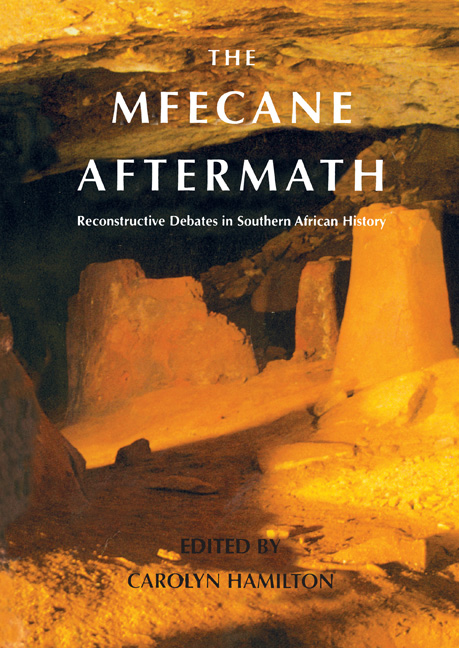Book contents
- Frontmatter
- Contents
- Maps
- Preface
- Acknowledgements
- Notes on Orthography and Names
- Contributors
- Introduction
- Part One Historiography and Methodology
- Part Two The South-Eastern Coastal Region
- Part Three The Interior
- ‘The Time of Troubles’: Difaqane in the Interior
- 11 Archaeological Indicators for Stress in the Western: Transvaal Region between the Seventeenth and Nineteenth Centuries
- 12 Prelude to Difaqane in the Interior of Southern Africa C.1600-C.1822
- 13 Conflict in the Western Highveld/Southern Kalahari c.1750-1820
- 14 ‘Hungry Wolves’: The Impact of Violence on Rolong Life, 1823-1836
- 15 The Battle of Dithakong and ‘Mfecane’ Theory
- 16 Untapped Sources: Slave Exports from Southern and Central Namibia up to c. 1850
- Glossary
- Abbreviations
- Bibliographer's Note
- Bibliography
- Complete List of Papers Presented at the Colloquium
- Index
15 - The Battle of Dithakong and ‘Mfecane’ Theory
from Part Three - The Interior
Published online by Cambridge University Press: 31 May 2019
- Frontmatter
- Contents
- Maps
- Preface
- Acknowledgements
- Notes on Orthography and Names
- Contributors
- Introduction
- Part One Historiography and Methodology
- Part Two The South-Eastern Coastal Region
- Part Three The Interior
- ‘The Time of Troubles’: Difaqane in the Interior
- 11 Archaeological Indicators for Stress in the Western: Transvaal Region between the Seventeenth and Nineteenth Centuries
- 12 Prelude to Difaqane in the Interior of Southern Africa C.1600-C.1822
- 13 Conflict in the Western Highveld/Southern Kalahari c.1750-1820
- 14 ‘Hungry Wolves’: The Impact of Violence on Rolong Life, 1823-1836
- 15 The Battle of Dithakong and ‘Mfecane’ Theory
- 16 Untapped Sources: Slave Exports from Southern and Central Namibia up to c. 1850
- Glossary
- Abbreviations
- Bibliographer's Note
- Bibliography
- Complete List of Papers Presented at the Colloquium
- Index
Summary
This essay aims to explore the relationship between the battle of Dithakong (1823) and ‘mfecane’ theory in the context of the growing critique of the theory led by Julian Cobbing. The essay seeks to establish the original version of events at Dithakong, and argues that with particular reference to the upheavals west of the Drakensberg in 1822-4 certain aspects of the theory may be tenable.
Up to the present, ‘mfecane’ theory has dominated the literature of early nineteenth-century history of the southern African interior, emphasising the self-generated and Afrocentric nature of the immense upheavals within black society during the 1820s. Ever since Cobbing questioned whether the ‘mfecane’ occurred in this sense, and suggested rather that the destabilisations sprang from European penetration, there have been efforts both by himself and his students to give his ideas academic credibility. Key events within the ‘mfecane’ diaspora have been identified and explained in terms of the larger suppositions of European expansionism and labour demands, and without reference to African agents involved in a knock-on process from the east. Dithakong is one such case study that stands at a critical juncture for these ideas with particular respect to the chains of violence west of the Drakensberg. Consequently, there has been a range of interpretations of the battle of Dithakong that seek to incorporate it within the broader theoretical framework proposed by Cobbing.
Dithakong is situated on the western fringe of what has been termed the ‘blank space’ - the Vaal-Caledon region - which was supposedly devastated by numerous ‘hordes’ in the years 1822-3. Few literate reporters had penetrated this area by 1823. At the moment of the disruptions, then, there are few eyewitness accounts of contemporary events. However, the occurrences at Dithakong on 25-27 June 1823 stand as one key exception with the eyewitness narratives of three Europeans. Dithakong, therefore, constitutes a locality of relatively sure empirical ground with regard to the nature of violence in the interior and so is catalyst to the very heart of the broader issues at stake.
- Type
- Chapter
- Information
- Mfecane AftermathReconstructive Debates in Southern African History, pp. 395 - 416Publisher: Wits University PressPrint publication year: 1995

